#Richard Trevithick
Text
27th December
St John the Evangelist’s Day

John the Evangelist. Source: Catholic Answers website
Today is the feast day of St John the Evangelist. John was a close companion, some say brother, of Jesus who, several years after his death, wrote the most unique of the four Gospels. John’s version of Jesus’ life and teachings was perhaps the most self-consciously theological of the texts, apparently strongly influenced by Gnosticism, which explains John’s status as patron saint of theologians. His emblem was the eagle. Some say that this was because John kept one as a pet; others that the bird is an allegory of John’s mysticism reaching for the sun - like a eagle.
John was often invoked to stave off the forces of darkness. Faeries and malign spirits will not molest anyone who wears on his or her person a piece of St John’s Gospel, which sounds like a rather destructive way to obtain a good luck charm.
On this day in 1801, the ambitious engineer, Richard Trevithick, launched the first steam-powered vehicle on the roads of Britain. Although his friend and fellow engineer, James Watt, had warned him that his prototype had too much pressure in the engine, Trevithick nonetheless insisted on taking some of his friends for a Christmas pint at the local tavern, driving them - very slowly - to the pub in his new-fangled vehicle. While the group were in the tavern enjoying a festive ale, their transport exploded outside. This proved Watt correct and also represented the first mechanised road traffic accident in recorded history.
#st John the evangelist#st John’s gospel#gnosticism#Richard trevithick#James watt#the gospels#eagles
1 note
·
View note
Text
The 219th Anniversary of the Penydarren Locomotive

View On WordPress
1 note
·
View note
Text
many people believe that Autism is a fairly new phenomena with the rising rates of diagnosis, but that'd be misleading! Autism has actually been a thing since 1804, when Richard Trevithick invented the Steam Locomoti-
153 notes
·
View notes
Note
In the Thomas Universe, do you think the topic of the engines being sentient ever came up in ethical debates? And, if so, do you think there would've been some sort of movement that would've been against scrapping steam engines during the BR era?
Absolutely there are ethical debates about it. Have been since the moment the first engine spooked Richard Trevithick into falling comically backwards into a wastebasket.
What is the upshot of those debates? I hate to be a downer, but working animals (and animals for slaughter, for that matter) are also sentient and there have been a lot of ethicists objecting all the while but they were and are killed when Economics. I get that engines are also sapient but humans are too and that's never stopped other humans from treating them as disposably as possible on the slightest pretext of “not human like us, dahling.” Remember that locomotives were developed at the height and in the heart of the British Empire. 😐
So there are undoubtedly movements to treat engines humanely but that's not the same as governments legally acknowledging their rights.
I think the preservation movement would be a lot bigger and better-funded and would rescue more if vehicles could talk, but it would still simply be a gift bestowed on those who are important and 'deserving' enough. Call me a cynic but I don’t see things as a whole changing under capitalism.
If you wanted a more optimistic, shatter-reality-coz-reality-sucks, fightin' answer then you of course need to check out @joezworld's masterpost. (Actually you need to check it out even if you didn't.)
#chatter#ttte analysis#no more heavy asks for today please and thanks#wanna go back to crazy shit and character appreciation#ttte
25 notes
·
View notes
Text
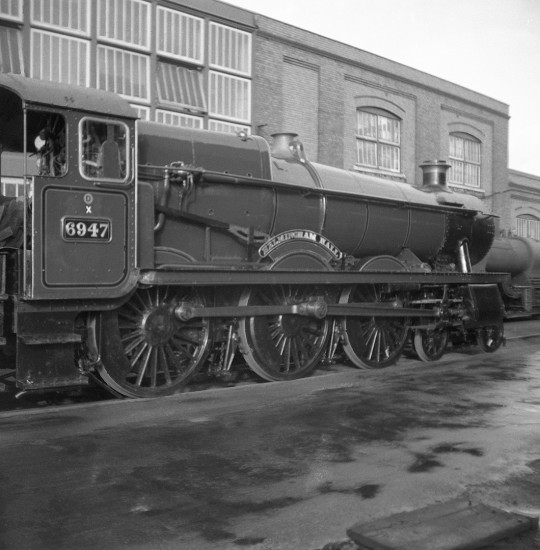

Ex-GWR ‘Hall’ Class 4-6-0 No 6947 ‘Helmingham Hall’ in ex-works condition outside its birthplace, Swindon Works, 24 November 1963. Built at Swindon Works in 1942 this loco was withdrawn from Oxford shed in November 1965 and scrapped.
Photo credits: Julian Holland
BRITAIN’S STEAM LOCOMOTIVES
From Penydarren to Tornado
It is now over 200 years since the world’s first steam railway locomotive made its maiden voyage along a primitive plateway in South Wales – in 1804 Richard Trevithick’s high-pressure steam locomotive successfully hauled a loaded train a distance of nine miles at an average speed of just over two mph. Only 25 years later Robert Stephenson’s Rocket won the Rainhill Trials in Lancashire with a top speed of nearly 30 mph. With Britain leading the way the evolution of the steam locomotive continued unabated through the 19th and into the 20th centuries, culminating in Nigel Gresley’s streamlined Mallard which still holds the world record for steam railway locomotives of 126 mph that was set in 1938.
Although steam haulage on Britain’s nationalized railways ended in 1968, the British public’s love affair with these living mechanical monsters continues unabated – steam haulage on the country’s national rail network and heritage railways is now a regular feature with packed trains being hauled by lovingly restored locomotives that were saved from the scrapheap some decades ago. Britain’s love affair with steam is set to continue.
Written by bestselling railway author Julian Holland, Britain’s Steam Locomotives is a fitting memorial to over two centuries of British steam locomotive design.
6 notes
·
View notes
Note
//All these random facts about emmet well here’s a random fact for you.
The starly that is with emmet is a known criminal in Sinnoh :)
//NO NOT RICHARD!! (yes he named it Richard, after Richard Trevithick) oh nooooo. I hope it doesn't do something horrible...//
3 notes
·
View notes
Text
So.. my history exam is on tuesday and I'm Stressed with a capital S.
I'm very scared of blanking on the day, so I've decided that every evening between now and then I'm gonna share some facts relating to whatever I've learned.
Hopefully It'll help me remember and you might even learn something :)
•○•○•
(We're covering the industrial revolution in Britain, the impact of the Great War on Scotland, and the Nazis contol of 1930s Germany):
•○•○•
The first steam powered locomotive (not engine, locomotive) was invented by Richard Trevithick in 1804 for his iron works at Pennydarren (Wales). It could pull 10 tons of iron but was highly unreliable.
Munitionettes produced 80% of all weapons used by the British army over the course of WWI. By 1918 they numbered 31,500 and had gained the nickname canaries as the poisons they worked with turned their skin yellow.
Britain shipped 3.2 million tons of food to the front lines during WWI ('food priorities' which were part of the reason rationing was introduced). There was also 300,000 employed to cook or supply food to the front lines.
The Munich Putsch occurred on the 8th/9th November 1923 and saw the deaths of 16 Nazis and 4 policemen. Following the Putsch, Hitler was arrested and sentenced to 5 years in prison, although he only served 9 months. During this time he wrote his autobiography: 'Mein Kampf' which would later replace the Bible in the Reich Church.
The Swing Kids were a Nazi opposition group who defined themselves in swing culture. They partook in non violent refusal of civil order and Nazi culture. They would listen to swing music which was considered 'black' and therefore unacceptable, and wore all the latest American fashions which were seen as immodest and not inkeeping with the Nazis view of women.
4 notes
·
View notes
Text
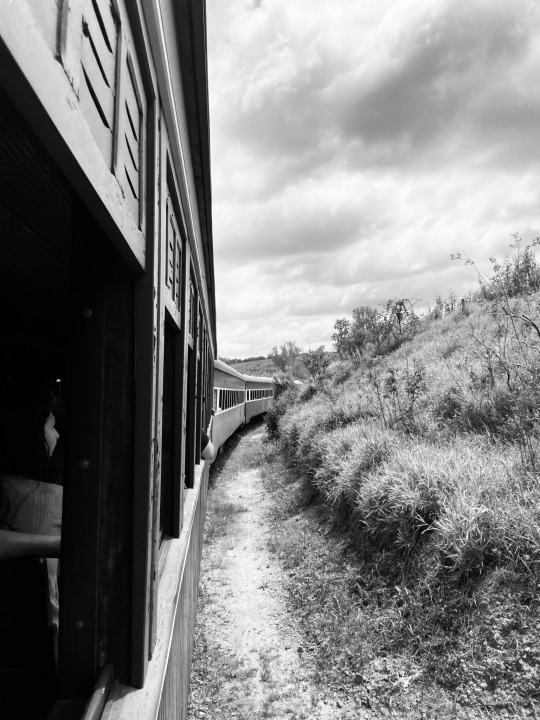



Locomotiva a vapor
locomotiva que produz sua força de tração através de um motor a vapor.
Esse tipo de locomotiva a vapor – Crampton – foi construído em vários países de 1846 a 1864.
Era utilizada para transporte de passageiros por ter estabilidade e velocidade, obtidas por 2 rodas motrizes, pistão curto e vapor de alta pressão.
Podia conduzir de 12 a 16 vagões (de 100 a 130 toneladas), a 60 km/h. Isolada, pesava 30 toneladas e podia alcançar 120 km/h.
A primeira locomotiva a vapor usando trilhos foi construída pelo engenheiro inglês Richard Trevithick e fez o seu primeiro percurso em 21 de Fevereiro de 1804. A locomotiva conseguiu puxar cinco vagões com dez toneladas de carga e setenta passageiros à velocidade vertiginosa de 8 km por hora usando para o efeito trilhos fabricados em ferro-fundido.
#trembala#analogic camera#fotography#impulse tag#black and white#original photographers#photography#kodak#nikon#cameras#fotografia#black#lovephotography#fotografia analogica#nikonphotography#felipeandradephotography#saopaulo#film photography#analog#art#architecture#sculpture#analogico#nikond40#4kphotos#iphone 11#loveblack#fotografiarua#mg#vintage
9 notes
·
View notes
Photo




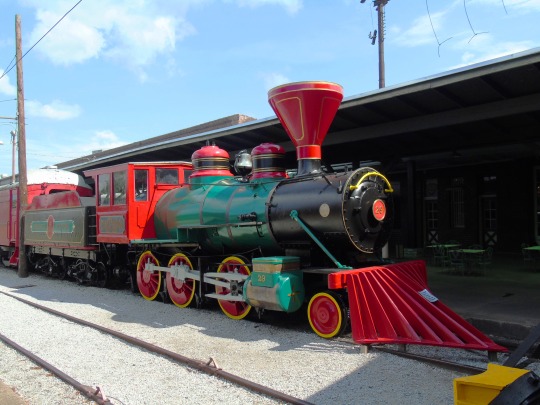

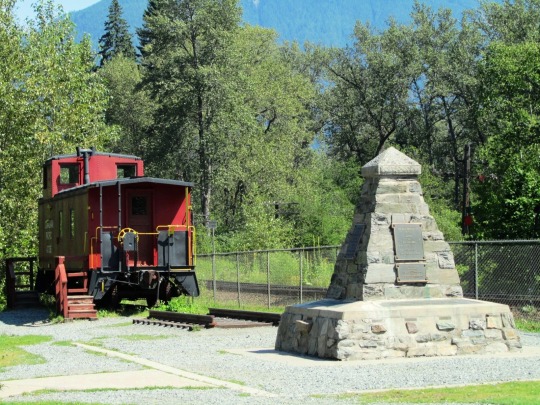



National Train Day
Go out and take a ride on a train, or watch them go by from a comfortable vantage point, whether fast, sleek commuter trains or large, loud steam engine transporters.
They cross thousands of miles across the countryside all over the world, transporting goods and passengers to places far-flung, and bringing back the same to their point of origin.
Two gleaming lines of silver lay their path as they move through cities and forests, mountains, and plains to bring everything to those who need it, whether it’s cargo or people. Of course, we’re talking about trains, those powerful machines that inspired so much of history, and have done amazing things for economies and industry all over the world.
National Train Day commemorates these beautiful machines and the role they play in our lives.
History of National Train Day
The history of National Train Day is the history of trains, and that history goes back farther than you might suspect. Railroads were actually a progression from wagonways, which were essentially railroads powered by horses, and have a history going back over 2000 years.
The first example of what we might call a “train track” emerged near Corinth in Ancient Greece in around 600 BC. Men and animals would pull boats along grooves in limestone across a five-mile course to their destination in the sea. The Romans did something similar in Roman Egypt.
The reason wagonways (and of course railways) came into existence was one of pure practicality: you could transport larger loads over a greater distance with prepared paths!
The first modern ‘ways’ weren’t even created with metal rails, they were instead created with wooden rails, and in the distance path even cut-stone tracks. By being carefully prepared, you could increase the amount a single horse could haul from one ton to nearly 13 tons! That’s a considerable improvement in cargo capacity and a massive boon to those who have to move a lot of it a good distance.
Of course, with wooden rails, they had to be often replaced, and so it became common practice to cover them with a thin metal plate to help the wood last.
The industrial revolution changed all that, and metal rails became more prominent. Around 1750, industry began producing dramatically more iron than at any point in the past. New techniques made possible by the modern science of metallurgy and engineering created the conditions for an output explosion.
With increased supply, the price of tracks began to fall. It suddenly became feasible to lay more of them, replacing the problem-stricken wooden versions that tended to break often.
There was still a problem, though: some consignments had a nasty habit of veering off the rails – literally! In response, an industrial innovator and colliery manager called John Curr saw that the problem was flat wheels. He realized that you needed some way to keep the wagon on the line. His idea was to create an L-shaped profile to the wheel on the inside that would prevent it from slipping off the track.
Of course, none of this early development mentions steam-powered locomotives – the thing that people think about first when they talk about trains. The actual steam engine only emerged in 1769 following James Watt’s proof-of-concept. But even he didn’t see the potential. He wanted to use steam to power wheels in factories, not necessarily trains.
It took more than thirty years for the first fully functional steam locomotive to appear in 1804 under the direction of Richard Trevithick. Trevithick, however, didn’t manage to commercialize the idea. While he built plenty of demonstrations, he didn’t have the means to put it to good use. Thus, the first commercial train journeys only began in 1812, and on a tiny scale.
But, of course, we all know what happened next: trains took over the world. They gave birth to our modern, productive civilization and transformed the life of the average person forever.
Because trains played a big part in our collective history, it was only a matter of time before someone, somewhere developed the idea of hosting a “train day.” An event like this would be a chance for everyone in the world who has benefited from locomotives to celebrate their valuable role, choo-chooing humanity into the future.
In 2008, Amtrak established National Train Day to help celebrate the history of the locomotive. The idea was to engage the general public more on the subject of trains and their history in the development of the modern world. National Train Day was a homage to the efforts of our ancestors in building out the rail network. It focuses, particularly on the transcontinental railway. During its heyday, National Train Day was a major event. While Amtrak was the clear lead, museums and other institutions related to trains all took part. Even charities got involved, seeing it as an excellent opportunity to fundraise.
Amtrak decided to host events every year, but, unfortunately, got into financial trouble. The firm closed its official National Train Day in 2015. That, however, wasn’t the end of the matter. Enthusiasts loved it so much, they carried on celebrating the occasion in the years that followed.
How to celebrate National Train Day
The best way to celebrate National Train Day is to go out and take a ride on a train! It doesn’t matter where it’s going, riding a train can be a fantastic and relaxing experience.
Some towns have steam trains that are part of their history and still in operation, and dinner trains are always a nice experience. Or, if you’re planning on taking a trip, rather than taking a car or plane, take a train for a relaxing ride across the country. National Train Day is a great chance to go out and see the world and experience these amazing vehicles.
Source
#Toronto Railway Museum#Be 68 Krokodil#Verkehrshaus der Schweiz#travel#Swiss Museum of Transport#Dampflok C 56 Elefant#Elko#Luzern#Lucerne#Chattanooga#Craigellachie#Kingman#Mora#Sweden#Canada#USA#13 May 2023#original photography#tourist attraction#landmark#indoors#outdoors#National Train Day#NationalTrainDay#Second Saturday in May#technology#cityscape
6 notes
·
View notes
Text
It's come to my attention that the surname used by some for the Submas twins is actually the last name of the man who invented the steam locomotive (Richard trevithick) and I think that's one of the best things to come out of fandom in a while lol
4 notes
·
View notes
Text
D.A.R.T., ou la fin de l’Impuissance Stellaire.
Le 24 novembre dernier, la base militaire californienne de Vanderberg est en pleine émulation. En effet, au sommet d’une fusée Falcon 9 produite par Space X (coucou Elon), se trouve un petit satellite prénommé DART (Double Asteroid Redirection Test). Au-delà de signifier « fléchette » en anglais, ce petit satellite est le premier de son genre, fabriqué dans un but bien précis : modifier l’orbite d’un objet céleste. Le satellite avait pour mission de parcourir les 11 millions de kilomètres le séparant d’un ensemble d’astéroïdes se trouvant entre notre orbite terrestre et l’orbite de Mars, et de venir s’écraser sur le plus petit d’entre eux, Dimorphos, pour tester notre capacité à potentiellement dévier un astéroïde menaçant de s’écraser sur Terre. DART, qui achèvera sa mission cette nuit (26/27 septembre 2022), est le premier essai de vaisseaux kamikazes ayant pour objectif de protéger la Terre d’une Apocalypse venue des étoiles. La solution que représente ce bijoux de technologie à 330 millions de dollars va au-delà de la simple résolution d’un problème quelconque. Selon moi, DART est le résultat d’une opération philosophique et métaphysique bien plus conséquente, et le symptôme d’une obstination purement humaine à l’auto-conservation à tout prix. Voyons ce que signifie en réalité le lancement de ce satellite.
Il existe bon nombre d’œuvres de fiction nous présentant le postulat d’un crash d’astéroïde imminent sur la planète Terre. Deep Impact, en 1998, Armaggedon la même année et plus récemment Don’t Look Up en 2022, tout ces films prennent comme postulat le crash d’un objet céleste. Ce thème est alors objectivement une raison tout à fait valable à l’extinction rapide et brutale de la race humaine. Et la découverte du cratère dans la péninsule de Yucatan au Mexique ayant sûrement causé la disparition des dinosaures n’a pas arrangé l’effroi de l’Apocalypse par un astéroïde. Ce sujet est intéressant car ce qu’il représente est très proche de la punition divine : quelque chose de massif, venu du ciel, vient rayer la vie de la surface de la Terre, la colère divine dans toute sa splendeur. Méritée ou non, cette prétendue colère, les humains tentent de s’en protéger depuis un bon moment, et DART est le symptôme d’une angoisse quasi-existentielle. Non, les humains ne finiront pas comme les reptiles géants du passé, non les humains sont plus fins que ça, ce ne sont pas les étoiles qui leur dicterons le droit de vie et de mort. Alors les humains vont dépenser des sommes littéralement astronomiques dans un petit satellite au nom adorable pour qu’il s’écrase violemment (bye bye les 330 millions) sur un objet céleste test. En réalité, ce projet de la NASA est la réponse technique que l’Humanité a trouvé à ce qui ressemble le plus au Destin en personne.
C’est par la technique (tekhnè ou τέχνη en grec ancien) que l’Homme s’est extirpé de sa condition animale. C’est la culture, différente de la nature, qui a offert à l’Homme la capacité de prendre son Destin en main. Le vaccin contre la variole par Edward Jenner en premier lieu, puis contre la rage en 1885 par Louis Pasteur étaient les preuves que l’Humanité, par la tekhnè, pouvaient anéantir les maladies. Richard Trevithick en 1804 avec la première locomotive à vapeur était la preuve que l’Humanité n’était pas vouée à ramper sur ses jambes pour l’éternité. Toutes ces inventions, l’énergie nucléaire, le moteur à explosion, Apollo 13 et les grands pas pour l’Humanité d’Amstrong sur la Lune, ont repoussé les limites de ce que l’Humanité pouvait appeler la Fatalité, c’est-à-dire les frontières qu’un mortel ne pouvait pas franchir. Aujourd’hui, c’est de l’Apocalypse céleste que se prévient l’Humanité. DART est le premier outil technique d’une, sans doute, longue série d’autres vaisseaux kamikazes : il signifie le début d’une possible défense terrestre contre des menaces stellaires. C’est en cela que le projet est d’une impressionnante folie. Ni positif, ni négatif, ce dispositif représente l’avènement d’une nouvelle ère culturelle pour l’Homme. Au fil des siècles, l’Humanité a réglé la question de la mort offerte par la nature : les maladies, a réglé la question de la distance et du transport, et maintenant elle est en voie de régler son Impuissance Stellaire.
La tekhnè semble grignoter de plus en plus de terrain sur la Mort, une pensée tantôt terriblement excitante, tantôt insupportablement déprimante.
2 notes
·
View notes
Text
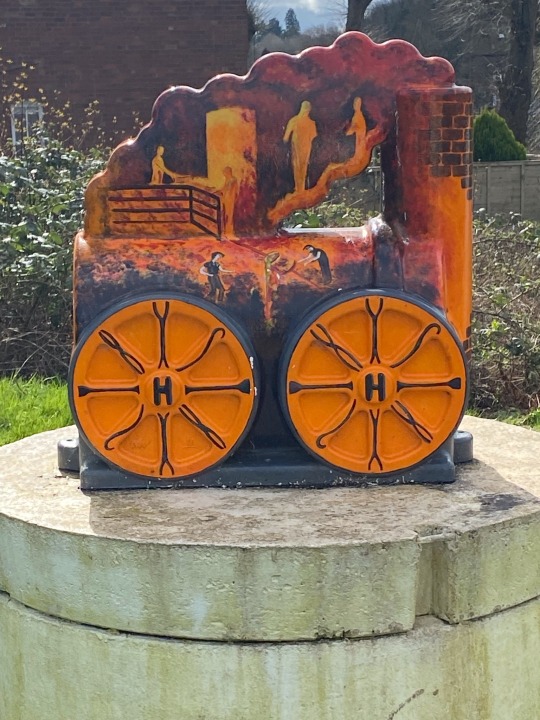
Sitting on the bank of the River Severn sits a memory of Hazledine’s Foundry. Where in 1808 was built the World’s first steam locomotive to haul fare paying passengers. The engine was designed by Richard Trevithick, engineered by John Urpeth Rastrick and built by the Foundry Workers of Bridgnorth, Shropshire
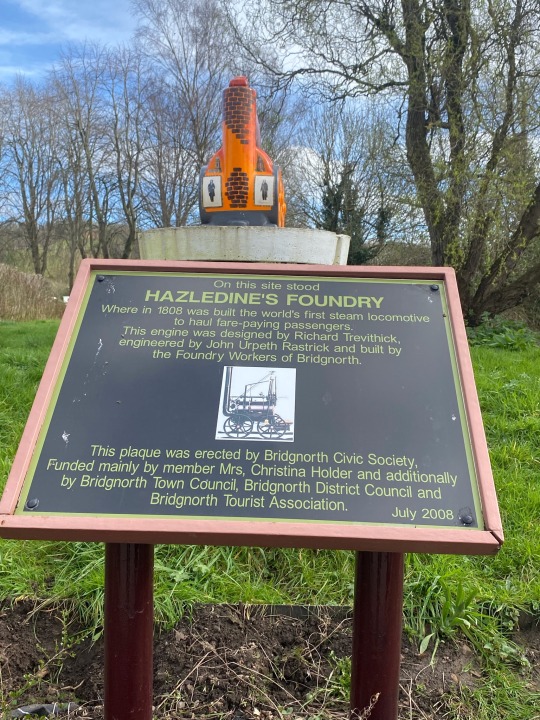
0 notes
Text
railroad spiel
🎰🎲✨ Erhalten Sie 500 Euro und 200 Freispiele, plus einen zusätzlichen Bonus, um Casinospiele mit nur einem Klick zu spielen! ✨🎲🎰
railroad spiel
Die Geschichte der Eisenbahn reicht bis in das frühe 19. Jahrhundert zurück. Die Entstehung der Eisenbahn revolutionierte den Transport und hatte einen enormen Einfluss auf den Handel und die Industrie. Die Entwicklung der Eisenbahn begann in Großbritannien und breitete sich dann rasch auf der ganzen Welt aus.
Die erste funktionierende Dampflokomotive wurde 1804 von Richard Trevithick in England entwickelt. Diese frühen Dampflokomotiven fuhren auf Holz- oder Metallschienen und wurden hauptsächlich zum Transport von Kohle in Bergwerken verwendet. Die erste öffentliche Eisenbahnlinie, die für den Personenverkehr genutzt wurde, wurde 1825 zwischen Stockton und Darlington in England eröffnet.
Die Eisenbahn verzeichnete schnell eine enorme Expansion und Entwicklung. In den 1830er Jahren wurden in Großbritannien viele wichtige Eisenbahnlinien gebaut, darunter die erste interurbane Eisenbahnlinie zwischen Liverpool und Manchester. Diese neue Transportmethode ermöglichte eine schnellere und zuverlässigere Beförderung von Waren und Personen.
Während des 19. Jahrhunderts wurde die Eisenbahn zum Symbol des Industriezeitalters. Sie trug zur raschen Industrialisierung bei und ermöglichte den Transport von Waren über weite Strecken. Der Bau von Eisenbahnstrecken war eine enorme technische und logistische Herausforderung. Um den steigenden Bedarf zu decken, wurden Hochgeschwindigkeitszüge entwickelt, die es ermöglichten, noch größere Strecken in kürzerer Zeit zurückzulegen.
Im Laufe der Zeit wurden neue Technologien eingeführt, wie zum Beispiel Elektrizität und Verbrennungsmotoren, um die Leistung und Effizienz der Züge weiter zu verbessern. Heutzutage sind Hochgeschwindigkeitszüge zu einem wichtigen Transportmittel geworden, insbesondere in Ländern wie Japan und Deutschland.
Die Geschichte der Eisenbahn ist geprägt von technologischen Fortschritten, die den Transport revolutioniert haben. Sie hat nicht nur die Mobilität der Menschen verbessert, sondern auch zur Entwicklung der modernen Gesellschaft beigetragen. Die Eisenbahn bleibt auch heute eine wichtige Säule des Transportsystems und wird voraussichtlich auch in Zukunft eine wesentliche Rolle spielen.
Eisenbahnmodelle: Eine faszinierende Welt der Miniaturzüge
Eisenbahnmodelle sind seit langem bei Jung und Alt gleichermaßen beliebt. Diese faszinierende Hobbywelt ermöglicht es den Enthusiasten, eine eigene Miniatur-Eisenbahnwelt zu schaffen. Das Sammeln und Bauen von Eisenbahnmodellen bietet nicht nur Stunden voller Spaß, sondern auch eine einzigartige Möglichkeit, die Geschichte der Eisenbahn nachzuerleben.
Eisenbahnmodelle gibt es in verschiedenen Größen und Maßstäben, von kleinen Tischmodellen bis hin zu detaillierten Nachbildungen großer Lokomotiven im Maßstab 1:87. Diese Modelle sind oft mit authentischen Details wie beweglichen Teilen, Beleuchtung und realistischen Geräuschen ausgestattet, um ein möglichst originalgetreues Erlebnis zu bieten.
Einer der größten Vorteile des Eisenbahnmodellbaus ist die Möglichkeit, eine eigene Landschaft und Umgebung zu gestalten. Von malerischen Berghängen über sanft fließende Flüsse bis hin zu authentischen Bahnhöfen können Hobbyisten ihrer Kreativität freien Lauf lassen. Dieses Hobby erfordert ein gewisses Maß an Geschicklichkeit, da das Verlegen von Gleisen und die Gestaltung von Landschaften eine präzise Handhabung erfordern.
Darüber hinaus bietet der Modellbau eine hervorragende Gelegenheit, historische Eisenbahnmomente nachzustellen. Vom Dampfzeitalter bis zur modernen Hochgeschwindigkeitsbahn können Eisenbahnfans ihre Lieblingszugstrecken und -epochen zum Leben erwecken. Dies ermöglicht es ihnen, eine Verbindung zur Vergangenheit herzustellen und herabgekommene Bahnhöfe wieder zum Leben zu erwecken.
Für viele Menschen ist das Sammeln von Eisenbahnmodellen auch ein soziales Hobby. Es gibt zahlreiche Vereine und Treffen, bei denen Gleichgesinnte ihre Leidenschaft teilen und Erfahrungen austauschen können. Es ist eine großartige Möglichkeit, neue Freunde zu finden und gemeinsam an Modellbahnprojekten zu arbeiten.
Insgesamt sind Eisenbahnmodelle eine spannende Möglichkeit, die Welt der Eisenbahn in Miniaturform zu entdecken. Dieses Hobby bietet nicht nur Unterhaltung, sondern auch Bildung und die Möglichkeit, historische Szenen nachzustellen. Gleichzeitig fördert es Kreativität und Geschicklichkeit. Wenn Sie Interesse an der Eisenbahn und handwerklicher Gestaltung haben, könnte der Modellbau die perfekte Freizeitbeschäftigung für Sie sein.
Deutschland ist berühmt für seine effizienten und gut organisierten Zugverbindungen. Lassen Sie uns einen Blick auf drei der besten Zugreisen werfen, die Sie in Deutschland unternehmen können.
Die Romantische Straße:
Die Romantische Straße ist eine der bekanntesten und schönsten Zugstrecken in Deutschland. Diese Route führt Sie durch malerische Dörfer und historische Städte wie Würzburg, Rothenburg ob der Tauber und Füssen. Genießen Sie die atemberaubende Landschaft entlang des Rheins und erleben Sie die romantische Atmosphäre des Mittelalters. Die Zugreise entlang der Romantischen Straße ist perfekt für diejenigen, die einen Hauch von Nostalgie und Geschichte erleben möchten.
Die Deutsche Alpenstraße:
Für Naturliebhaber und Abenteurer ist die Zugreise entlang der Deutschen Alpenstraße ein absolutes Muss. Diese Strecke führt Sie durch majestätische Berglandschaften und charmante Dörfer in Bayern und Baden-Württemberg. Entdecken Sie die beeindruckenden Aussichten auf die Alpen und halten Sie an beliebten Wandergebieten wie Garmisch-Partenkirchen und Berchtesgaden an. Die Zugfahrt entlang der Deutschen Alpenstraße bietet eine unglaubliche Vielfalt an Landschaften und Aktivitäten für jeden Geschmack.
Die Rheinstrecke:
Die Zugreise entlang des Rheins ist eine der schönsten Zugstrecken Deutschlands. Entdecken Sie die malerischen Weinberge, mittelalterlichen Schlösser und charmanten Dörfer entlang des Rheins. Besuchen Sie berühmte Städte wie Köln, Bonn und Koblenz und erleben Sie die reiche Geschichte und Kultur dieser Region. Eine Zugfahrt entlang der Rheinstrecke ist die perfekte Möglichkeit, die Schönheit des Rheintals zu erkunden.
Diese drei Zugreisen bieten Ihnen eine einzigartige Möglichkeit, Deutschland und seine vielfältige Landschaft zu entdecken. Egal, ob Sie an Geschichte, Natur oder Romantik interessiert sind, es gibt für jeden etwas dabei. Planen Sie Ihre Reise und genießen Sie das Abenteuer einer Zugfahrt durch Deutschland!
Eisenbahnmuseen sind faszinierende Orte für Eisenbahnbegeisterte und Historiker gleichermaßen. In Deutschland gibt es eine Vielzahl von Eisenbahnmuseen, die die reiche Geschichte und die technologischen Fortschritte der Eisenbahn präsentieren. In diesem Artikel werden vier der bekanntesten Eisenbahnmuseen Deutschlands vorgestellt.
Das Deutsche Technikmuseum Berlin: Dieses Museum ist eines der größten seiner Art in Deutschland und beherbergt eine beeindruckende Sammlung von historischen Eisenbahnfahrzeugen. Besucher können hier verschiedene Dampflokomotiven, Elektro- und Dieselloks sowie historische Waggons bestaunen. Das Museum bietet zudem interaktive Ausstellungen und Veranstaltungen für die ganze Familie.
Das Verkehrsmuseum Nürnberg: In Nürnberg können Besucher eine Reise durch die Geschichte des Verkehrs unternehmen. Das Museum beherbergt nicht nur eine beeindruckende Sammlung von Eisenbahnfahrzeugen, sondern präsentiert auch andere Verkehrsmittel wie Autos, Flugzeuge und Schiffe. Das Highlight des Museums ist eine riesige Modellbahnanlage, die verschiedene historische Szenarien zeigt.
Das Deutsche Dampflokomotiv-Museum in Neuenmarkt-Wirsberg: Dieses Museum ist ein Paradies für Dampflok-Enthusiasten. Hier können Besucher zahlreiche restaurierte Dampflokomotiven bewundern und mehr über die Technologie und Funktionsweise dieser alten Maschinen erfahren. Das Museum bietet außerdem regelmäßig Vorführungen und Fahrtage mit historischen Dampfloks an.
Das DB Museum in Nürnberg: Als das offizielle Museum der Deutschen Bahn bietet dieses Museum einen umfassenden Einblick in die Geschichte der deutschen Eisenbahn. Besucher können hier verschiedene historische Lokomotiven und Waggons bewundern sowie interessante Ausstellungen über die Entwicklung des Eisenbahnnetzes und der Zugtechnologie erkunden.
Eisenbahnmuseen sind nicht nur für Eisenbahnbegeisterte interessant, sondern bieten auch eine spannende Möglichkeit, die Vergangenheit und die technischen Errungenschaften in der Eisenbahnindustrie zu entdecken. Egal, ob Sie sich für historische Dampflokomotiven, moderne Hochgeschwindigkeitszüge oder die Entwicklung des Schienennetzes interessieren, in den Eisenbahnmuseen Deutschlands gibt es viel zu entdecken.
Die Bahninfrastruktur in Deutschland spielt eine wichtige Rolle im öffentlichen Verkehrssystem des Landes. Sie umfasst ein weitreichendes Netzwerk von Schienen, Bahnhöfen und anderen Einrichtungen, die es Menschen ermöglichen, bequem und effizient mit der Bahn zu reisen.
Schienennetz: Das deutsche Schienennetz erstreckt sich über eine Länge von mehr als 33.000 Kilometern, was es zu einem der umfangreichsten Schienennetze der Welt macht. Es verbindet Städte, Gemeinden und Regionen im ganzen Land miteinander und ermöglicht schnelle und zuverlässige Zugverbindungen.
Hochgeschwindigkeitszüge: Deutschland verfügt über ein gut ausgebautes Hochgeschwindigkeitszugnetz, das es Reisenden ermöglicht, schnell und komfortabel von einem Ort zum anderen zu gelangen. Der bekannteste Hochgeschwindigkeitszug in Deutschland ist der ICE (Intercity-Express), der Geschwindigkeiten von bis zu 320 km/h erreichen kann.
Bahnhöfe: Deutschland verfügt über eine Vielzahl von Bahnhöfen, die als wichtige Verkehrsknotenpunkte dienen. Die größten Bahnhöfe, wie der Hauptbahnhof in Berlin oder der Hauptbahnhof in München, sind beeindruckende architektonische Meisterwerke und bieten eine Vielzahl von Annehmlichkeiten für Reisende, darunter Geschäfte, Restaurants und Hotels.
Güterverkehr: Die Bahninfrastruktur in Deutschland spielt auch eine wichtige Rolle im Güterverkehr. Das Schienennetz ermöglicht den reibungslosen Transport von Waren und Materialien von einem Ort zum anderen. Viele Unternehmen nutzen die Bahn, um ihre Produkte effizient und umweltfreundlich zu transportieren.
Zukünftige Projekte: Die deutsche Bahninfrastruktur ist stetigem Ausbau und Verbesserungen unterworfen. Es gibt verschiedene laufende und geplante Projekte, um das Schienennetz zu erweitern und zu modernisieren. Auch der Ausbau des Hochgeschwindigkeitszugnetzes ist ein wichtiger Schwerpunkt, um die Reisezeiten weiter zu verkürzen und den Komfort für die Fahrgäste zu verbessern.
Die Bahninfrastruktur in Deutschland spielt eine entscheidende Rolle für die Mobilität der Menschen und die wirtschaftliche Entwicklung des Landes. Durch den Ausbau und die Modernisierung des Netzes wird sichergestellt, dass die Bahn weiterhin eine attraktive Alternative zum Individualverkehr darstellt und eine umweltfreundliche Option für Reisen in Deutschland bleibt.
0 notes
Note
"He clearly never had any interest in worldbuilding." - I mean he built a whole fictional island with a history stretching back hundreds of years, with closed railways and fictional words and everything, just to have somewhere for his locomotives to live? I don't think he particularly cared where the faces come from, but it feels a bit harsh to say he wasn't interested in worldbuilding at all?
Yeah, that was a bit off-the-cuff. I was referring to the common criticism around here that he wasn't a worldbuilder in the sense of developing or even grappling with the science-fiction/fantasy aspects of his premise. He makes engines alive but posits that their sapience and individuality really have no impact on history as we know it. (In reality, if Richard Trevithick's steam engine had actually come alive and started talking intelligibly, it would have been THE event of the 19th century as far as culture, religion, and philosophy.)
As the creator of a fictional island, yeah, he was a trooper and a lore-spinner.
#it's charming to me how every autistic brit seems to be Like This though#they allllll make up their fictional places and their fictional histories and i'm fascinated by it as a cultural phenomenon#chatter#just awdry things
15 notes
·
View notes
Text
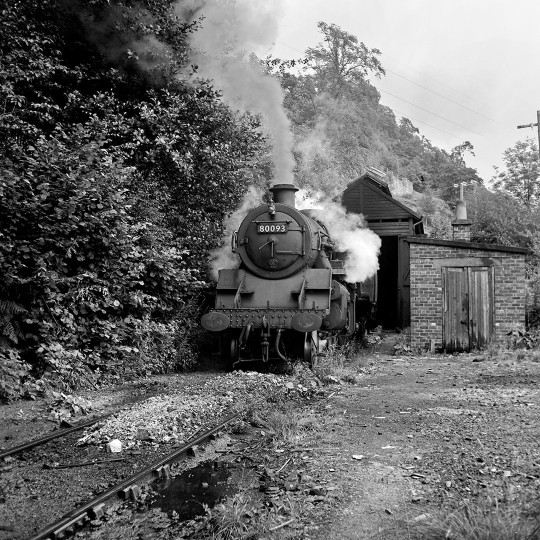
BR Standard Class ‘4MT’ 2-6-4T No 80093 simmers outside Loch Tay depot on 4th August 1965. The Glen Ogle landslide on 27th September of that year caused all services to Killin to be suspended, never to return. Official closure came on 1st November 1965. No 80093 was built at Brighton Works in 1954 and withdrawn from Perth shed in September 1966. Only 12 years old! What a waste!
It is now over 200 years since the world’s first steam railway locomotive made its maiden voyage along a primitive plateway in South Wales – in 1804 Richard Trevithick’s high-pressure steam locomotive successfully hauled a loaded train a distance of nine miles at an average speed of just over two mph. Only 25 years later Robert Stephenson’s Rocket won the Rainhill Trials in Lancashire with a top speed of nearly 30 mph. With Britain leading the way the evolution of the steam locomotive continued unabated through the 19th and into the 20th centuries, culminating in Nigel Gresley’s streamlined Mallard which still holds the world record for steam railway locomotives of 126 mph that was set in 1938.
Although steam haulage on Britain’s nationalized railways ended in 1968, the British public’s love affair with these living mechanical monsters continues unabated – steam haulage on the country’s national rail network and heritage railways is now a regular feature with packed trains being hauled by lovingly restored locomotives that were saved from the scrapheap some decades ago. Britain’s love affair with steam is set to continue.
Written by bestselling railway author Julian Holland, Britain’s Steam Locomotives is a fitting memorial to over two centuries of British steam locomotive design.
0 notes
Text
Here are my headcanons of Duck:
-He’s autistic due to his communication issues, speech patterns, repetitive language, trouble with controlling his emotions, feeling uncomfortable in unfamiliar situations, obsession with the sea, and hypersensitivity to touch, smell, and certain loud sounds.
-He might be Jewish due to the way how he speaks in the CGI series and he does have the facial features.
-Before 5750 and the same day as 5741’s built, he was the first 57xx Pannier to be built in Swindon but this all happened without the GWR’s permission. Due to this, he was built with uneven axles. Unexpectedly, he also had a mental disability and he couldn’t speak and understood social cues. He was considered to be scrapped until Cornish workers begged them to give him a chance. The first steam engines which were made by a Cornish man named Richard Trevithick had a lot of issues yet they made history. So they believed he had potential. Anyhow and before 7715, he’s the first 57xx Pannier to work in Cornwall.
-He was not given a number during his GWR days due to his issues
-Since he was a “surprise” engine, he has been through some modifications. Whereas he’s the only 57xx pannier to pull auto coaches. Along with being the only pannier to pull slip coaches.
-7715 is Duck’s younger sister, Jackie who is very spunky and tomboyish. They also have a close bond together.
-He was transferred to Paddington roughly in early 1941 to help out with the damage that was caused from the battle of the Britain
-While he was about to be sent to Sodor, workmen gave 5741’s old number plate to help him feel better
#duck the great western engine#thomas and friends#headcanon#fan theory#autism#tumblr sexyman#autistic headcanon
1 note
·
View note